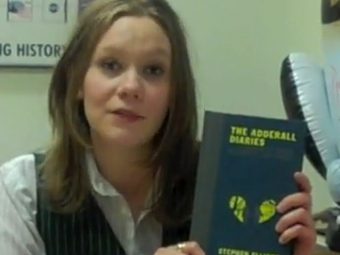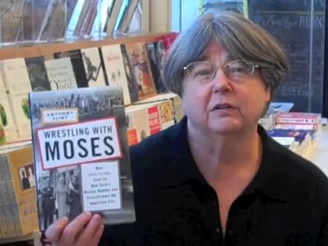|
Harvard Book Store Channel |
-
September 28, 2012
Steven Johnson
discusses Future Perfect: The Case For Progress In A Networked Age -
September 28, 2012
Natalie Hopkinson
discusses Go-Go Live: The Musical Life and Death of a Chocolate City -
September 21, 2012
Daniel Kantstroom
discusses Aftermath: Deportation Law and the New American Diaspora -
March 7, 2012
The Future of Black Politics
A panel discussion with Michael Dawson and William Julius Wilson, moderated by Eugene Rivers -
October 18, 2011
Ron Suskind
discusses Confidence Men: Wall Street, Washington, and the Education of a President -
March 4, 2011
Maya Jasanoff
discusses Liberty's Exiles: American Loyalists in the Revolutionary World -
February 25, 2011
Siva Vaidhyanathan
discusses The Googlization of Everything (And Why We Should Worry) -
February 24, 2011
Dani Rodrik
discusses The Globalization Paradox: Democracy and the Future of the World Economy -
February 18, 2011
Izzeldin Abuelaish
discusses I Shall Not Hate: A Gaza Doctor's Journey on the Road to Peace and Human Dignity -
February 17, 2011
Parag Khanna
discusses How to Run the World: Charting a Course to the Next Renaissance -
February 14, 2011
Dambisa Moyo
discusses How the West Was Lost: Fifty Years of Economic Folly and the Stark Choices Ahead -
February 10, 2011
Daniel Rasmussen
discusses American Uprising: The Untold Story of America's Largest Slave Revolt -
February 4, 2011
Sherry Turkle
discusses Alone Together: Why We Expect More from Technology and Less from Each Other -
January 27, 2011
Robert and Ellen Kaplan
discuss Hidden Harmonies: The Lives and Times of the Pythagorean Theorem -
January 24, 2011
Seth Mnookin
discusses The Panic Virus: A True Story of Medicine, Science, and Fear -
January 22, 2011
Christian Lander
discusses Whiter Shades of Pale: The Stuff White People Like, Coast to Coast, from Seattle's Sweaters to Maine's Microbrews -
January 14, 2011
Richard Wolffe
discusses Revival: The Struggle for Survival Inside the Obama White House -
December 7, 2010
Chris Kimball
The cast of America's Test Kitchen discusses their Healthy Family Cookbook -
November 3, 2010
The Best American Short Stories 2010
Series editor Heidi Pitlor joins guest editor, Richard Russo, and contributors Brendan Mathews and Steve Almond -
November 1, 2010
Gal Beckerman
Gal Beckerman discusses When They Come for Us, We'll Be Gone: The Epic Struggle to Save Soviet Jewry -
October 26, 2010
The Best American Essays 2010
Series editor Robert Atwan joins contributors John Summers and Jerald Walker -
October 25, 2010
Robert Kaplan
Robert Kaplan discusses Monsoon: The Indian Ocean and the Future of American Power -
October 15, 2010
Timothy Snyder
Timothy Snyder discusses Bloodlands: Europe Between Hitler and Stalin -
September 23, 2010
Guillermo del Toro and Chuck Hogan
Guillermo del Toro and Chuck Hogan discuss The Fall -
April 17, 2010
Mark Oppenheimer
Mark Oppenheimer discusses Wisenheimer: A Childhood Subject to Debate -
March 23, 2010
Christopher Hitchens and Rabbi David Wolpe
Christopher Hitchens and Rabbi David Wolpe weigh in on The Great God Debate -
February 17, 2010
Kevin Sampsell and Justin Taylor
Kevin Sampsell and Justin Taylor discuss A Common Pornography and Everything Here is the Best Thing Ever -
February 8, 2010
John Callahan and Adam Bradley
John Callahan and Adam Bradley discuss Ralph Ellison's Three Days Before the Shooting -
February 2, 2010
Rebecca Newberger Goldstein
Rebecca Goldstein discusses 36 Arguments for the Existence of God: A Work of Fiction -
January 8, 2010
Mika Brzezinski and Joe Scarborough
Mika Brzezinski and Joe Scarborough discuss All Things at Once -
December 3, 2009
Harry Evans and Jason Epstein
Harry Evans and Jason Epstein discuss My Paper Chase and Eating -
October 29, 2009
Harriet Reisen
Harriet Reisen discusses Louisa May Alcott: The Woman Behind Little Women -
October 23, 2009
Thomas Cathcart
Thomas Cathcart discusses Heidegger and a Hippo Walk Through Those Pearly Gates
-
December 19, 2013
Don’t Watch This If You Are a Bookseller’s Cousin or Mom
What is our discerning staff giving for the holidays? -
September 22, 2011
Minimum Paige: A Harvard Book Store Comic Anthology
A project this heroic could only be accomplished by the most dynamic of duos. -
September 16, 2011
Lucy the Wonder-Pup Picks the Booker
Can this adorable puppy predict the winner of the Man Booker Prize? -
January 21, 2011
HBTV Presents: Jurassic Books
A short film that ponders the possibilities of a large scale book printing robot... -
January 14, 2011
HBTV Is On The Air!
Cambridge's only local, fictional television station that's based out of an independent book store. -
September 8, 2010
Carole
recommends Wrestling with Moses and The Death and Life of Great American Cities
| Gift Cards |
-
Add a gift card to your order!

-
Representing the Race: The Creation of the Civil Rights Lawyer
by Kenneth W. MackOur Price $35.00Hardcover
On Its Way
Kenneth W. Mack
Harvard Book Store and The W.E.B. Du Bois Institute are pleased to welcome Harvard Law School's KENNETH W. MACK for a discussion of his new book, Representing the Race: The Creation of the Civil Rights Lawyer.
Representing the Race tells the story of an enduring paradox of American race relations, through the prism of a collective biography of African American lawyers who worked in the era of segregation. Practicing the law and seeking justice for diverse clients, they confronted a tension between their racial identity as black men and women and their professional identity as lawyers. Both blacks and whites demanded that these attorneys stand apart from their racial community as members of the legal fraternity. Yet, at the same time, they were expected to be “authentic”—that is, in sympathy with the black masses. This conundrum, as Kenneth W. Mack shows, continues to reverberate through American politics today.
Mack reorients what we thought we knew about famous figures such as Thurgood Marshall, who rose to prominence by convincing local blacks and prominent whites that he was—as nearly as possible—one of them. But he also introduces a little-known cast of characters to the American racial narrative. These include Loren Miller, the biracial Los Angeles lawyer who, after learning in college that he was black, became a Marxist critic of his fellow black attorneys and ultimately a leading civil rights advocate; and Pauli Murray, a black woman who seemed neither black nor white, neither man nor woman, who helped invent sex discrimination as a category of law. The stories of these lawyers pose the unsettling question: what, ultimately, does it mean to “represent” a minority group in the give-and-take of American law and politics?
Kenneth W. Mack is a Professor of Law at Harvard Law School, where he has taught since the 2000-01 academic year. He teaches courses on Property Law, American Legal History, Civil Rights History and the Legal Construction of Racial Identity. He is the author of a number of scholarly articles, and is a book entitled Representing the Race: Creating the Civil Rights Lawyer, 1920-1955. Prior to pursuing his Ph.D. studies in history, he was a law clerk for Federal District Judge Robert L. Carter of the Southern District of New York, as well as a trial and appellate litigator at Covington & Burling in Washington, D.C. During the first national elections in post-apartheid South Africa, he served as co-area director of election monitoring for the United States and Canada. Before turning to law, he pursued a career as an Electrical and Computer Engineer where he designed Computer Integrated Circuits at A.T. & T. Bell Laboratories.





















































































































































































































































